The Paddle Steamer Enterprise is the largest functional object at the National Museum of Australia. Launched more than 130 years ago, she is one of oldest working paddle steamers in the world. The Enterprise was listed on the Australian Register of Historic Vehicles in 2012.
The Enterprise illustrates the important role paddle steamers played in Australian history and as part of the National Museum collection, its story is also being preserved for future generations.
The Enterprise has worked as a cargo boat, floating store, fishing vessel, houseboat and showboat.
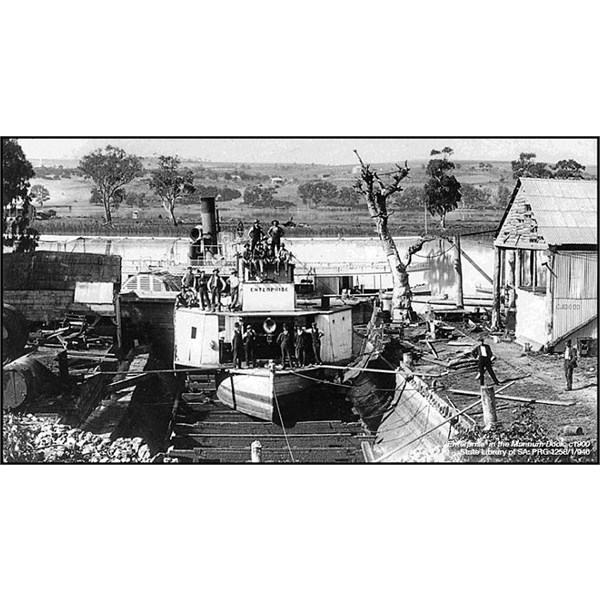
PS Enterprise in Randell's Dry Dock at Mannum
The vessel was launched in 1878 after being built in
Echuca from river red gum. These trees, once plentiful along the
Murray River, provided a ready source of hardwood for building and powering paddle steamers. The tannin from a handful of eucalyptus leaves thrown into the boiler also prevented the interior walls from corroding.
The Enterprise is known as a 'shallow drafter', because there is very little of it sitting below the water line — a mere 75 centimetres. This made it suitable for dealing with the varying water levels of the river system. In 1879 it managed to steam on the waterways throughout the year, despite falling river levels.
In years gone by paddle steamers were
home to many families, including the Creagers. Augustus Creager bought the PS Enterprise in 1919 and raised his
young family on board while working as a fisherman. From the 1930s he was assisted by his wife Hilda, who was one of the few women at the time to hold a commercial fishing licence.
Over the years a number of adjustments were made to the boat, including the construction of a new galley with a wood stove, and a new master bedroom. A steam hose from the boiler was used to heat water drawn from the river for bathing, washing and cleaning the decks.
Many aspects of life for the Creager children would have been different to a childhood spent on land. Imagine having to walk on a gangplank instead of a footpath to reach your front door.
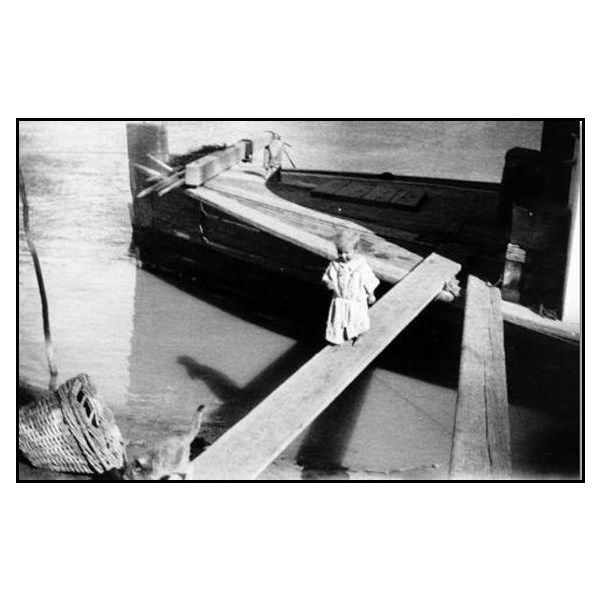
Jocelyn Creager, at 13 months, follows her cat along the gangplank
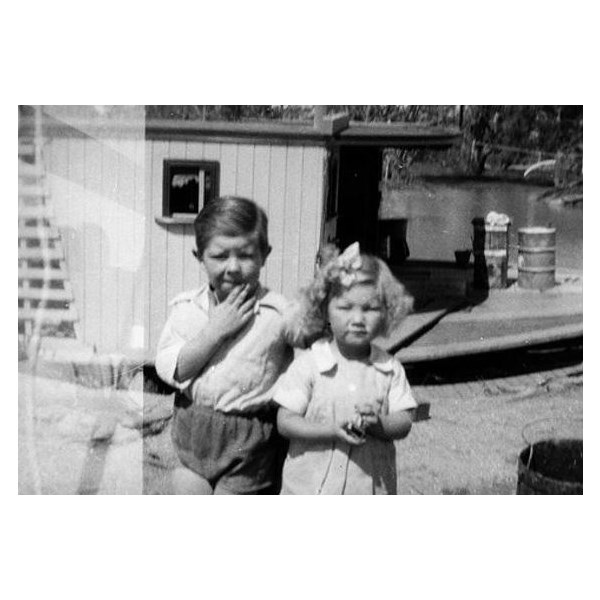
Two of the Enterprise's' youngest crew members, Ken and Jocelyn Creager
Living on the water did have its hazards for the Creager children. As toddlers, each of them fell overboard at least once. Mrs Creager displayed great calm and presence of mind by watching the trail of bubbles from the child and reaching into the water to rescue her offspring when he or she came to the surface!
Although the family lived on the boat, it was moored to a river bank for most of the time. This allowed the children to attend school, and Augustus to maintain a shed on the bank for his motor vehicles and tools. The Creagers also had a vegetable garden and a goat for milk.
The 1970s saw renewed interest in steamboats and their history. In 1973 enthusiasts Graeme Niehus and his father, Bru, restored the PS Enterprise and steamed her on the
Murray River. Later that year, the Enterprise was a special guest at the commissioning of a new paddle steamer,
Murray River Queen, on
Lake Alexandrina in South Australia. Commemorative bottles of wine produced by Angove were sold to help fund the Enterprise's restoration and voyages.
Graeme and Bru Niehus quickly found others who shared their passion and the idea to hold a series of steamboat races was born. In 1974, the Enterprise raced against PS Etona, with the event billed as a re-creation of the great 19th century paddle steamer rivalry between the Victorian 'top-enders' and the South Australian 'bottom-enders'. Enterprise lost the race, despite taking an early lead. During the late 1970s, Enterprise raced against a number of other steamboats, and was victorious on a number of occasions.
The PS Etona provided for the spiritual needs of the river communities, plying South Australian waters from 1899 to 1915 as a floating church. It carried a minister who performed weddings, christenings and religious
services, and also had an altar and organ on board.
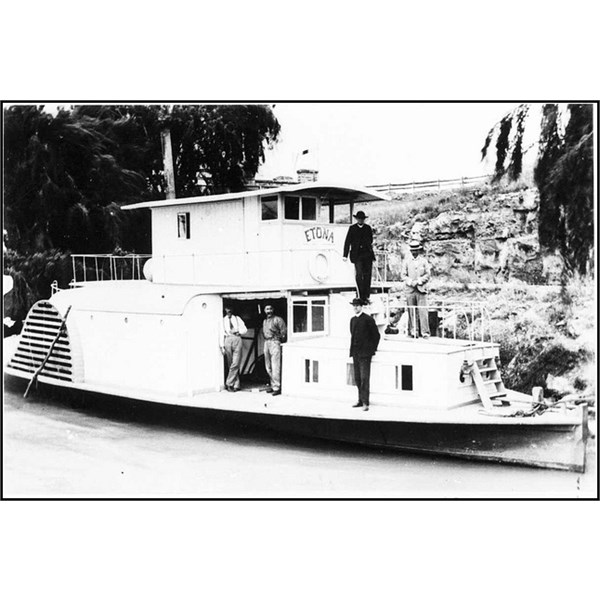
P.S. Etona, Mission steamer at Murray Bridge, 1900
In 1984 the PS Enterprise was purchased by the National Museum of Australia. It was restored in
Echuca, before being moved to its new
home on Lake Burley Griffin in
Canberra.
Since its arrival at the National Museum, the Enterprise has carried its working crew and special guests.
In 1993 the Enterprise was recommissioned for a day as HMA PS Enterprise for its role in the Royal Australian Navy Maritime Pageant. To mark the occasion, the Museum's paddle steamer carried as guests the then Chief of Naval Staff, Vice Admiral MacDonald, then Governor General Bill Hayden and then Chief of Defence Force, Admiral Beaumont.
The National Museum holds various objects associated with the PS Enterprise and the broader history of paddle steaming in Australia.
This includes early river charts, hand-drawn by riverboat captains as they travelled along waterways. The charts were typically drawn on starch-filled linen. The starch made the fabric rigid and easier to draw on. Some charts were more than a metre long and were rolled at both ends, allowing only the relevant section to be viewed at a time.
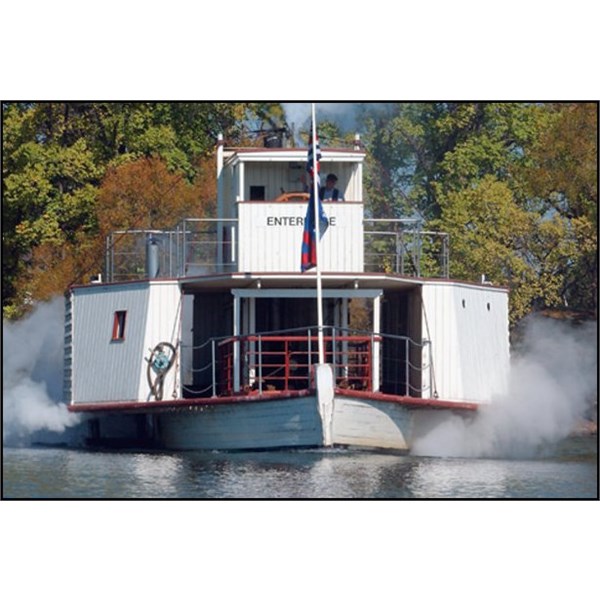
The PS Enterprise at full steam on Lake Burley Griffin in Canberra
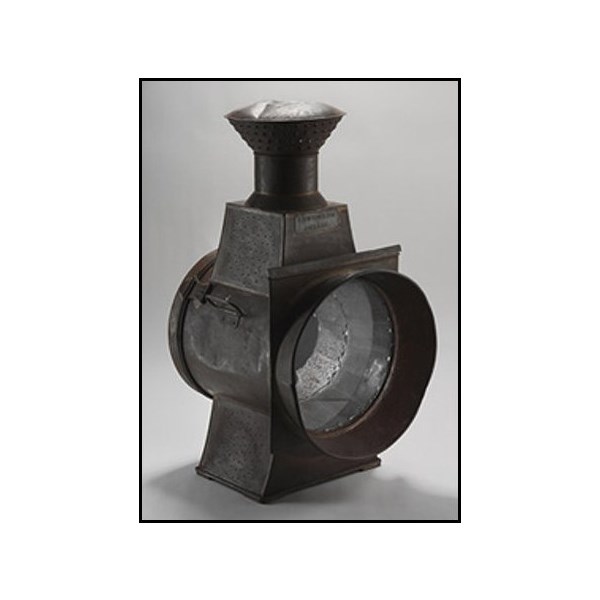
Acetylene lamp from the Enterprise, about 1910
The Museum also holds hundreds of items used on the vessel, many of them linked to the Creager family. The acetylene lamp pictured below was used from around the early 1900s to the 1920s and worked by burning the acetylene gas created when water dripped onto calcium carbide blocks. Lamps allowed steamers to travel at night as their broad beams of light illuminated banks and the river.
Inspired by the use of the Mississippi River in America as a water highway for paddle steamers, Australia's colonial governments thought a similar transport system might work in Australia.
Before the evolution of steam transport, goods and produce were moved by road, using bullocks and wagons. This was slow and arduous, especially at river crossings. If no punts were available, stock often had to be swum across the river and vehicles floated on barrels and rafts. River travel allowed traders to transport perishable goods to pastoralists on inland properties. In turn, pastoralists could ship their valuable wool clips to ocean ports for export to the mills of England much faster by river.

A wagon using Hopwood's punt to cross the Murray at Echuca about 1875
The first paddle steamer to successfully traverse the Murray–
Darling river system was the PS Mary Ann in 1853. Within a few years paddle steamers had become commonplace, giving rise to a booming industry based on river trade. Towns such as
Mannum,
Goolwa,
Wentworth and
Morgan thrived as ports on the river highway.
However, it was
Echuca, with its 1200-metre wharf, that became the undisputed river capital. In 1864 a rail link was established from
Echuca to
Melbourne. This made
Echuca the preferred destination of river trade because goods could reach their destination even faster.

River boats Loaded with wool at Echuca Wharf
At the same time, the paddle steamer industry was becoming more regulated and organised. Shipmasters now had to pass a
test for certification, and the
clearing of snags in the river made navigation much easier.
Paddle steamers filled a number of roles on the river. Many towed barges laden with wool, while others served as trading vessels. These carried fresh produce, mail and other goods, such as building materials and occasionally even musical instruments, to people living by the river. Paddle steamers also brought news from faraway cities and towns, and their arrival helped connect isolated communities.
.